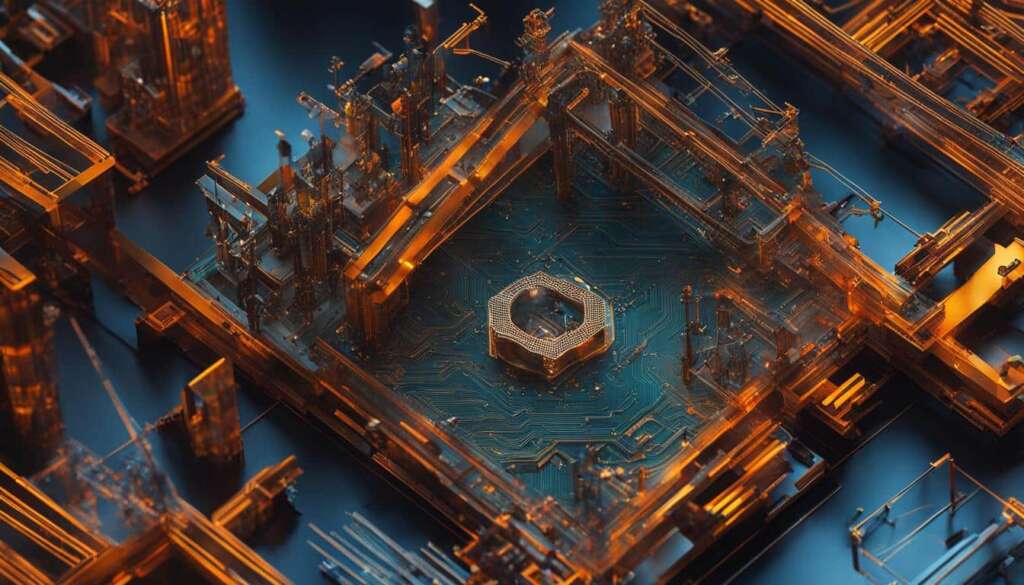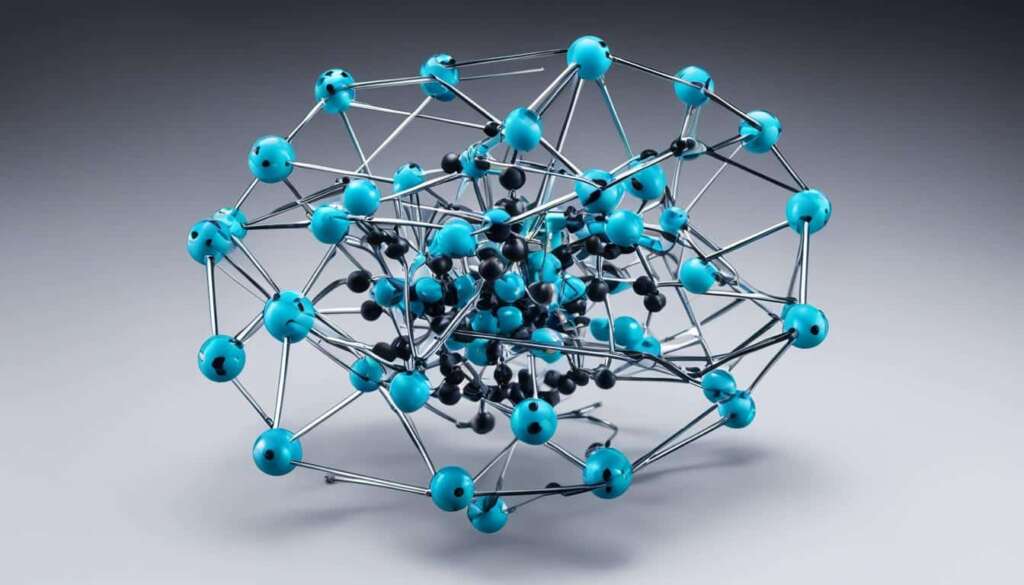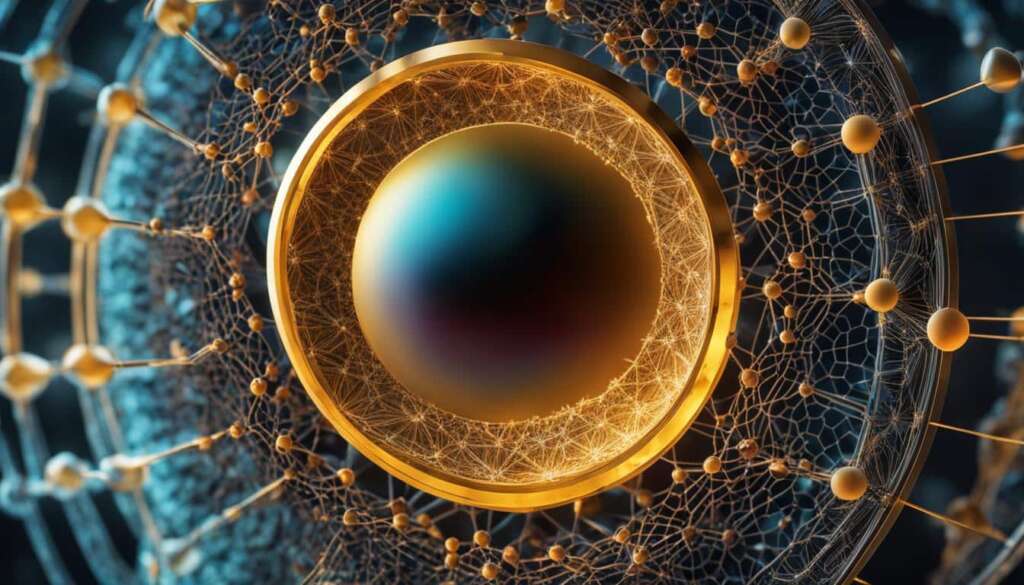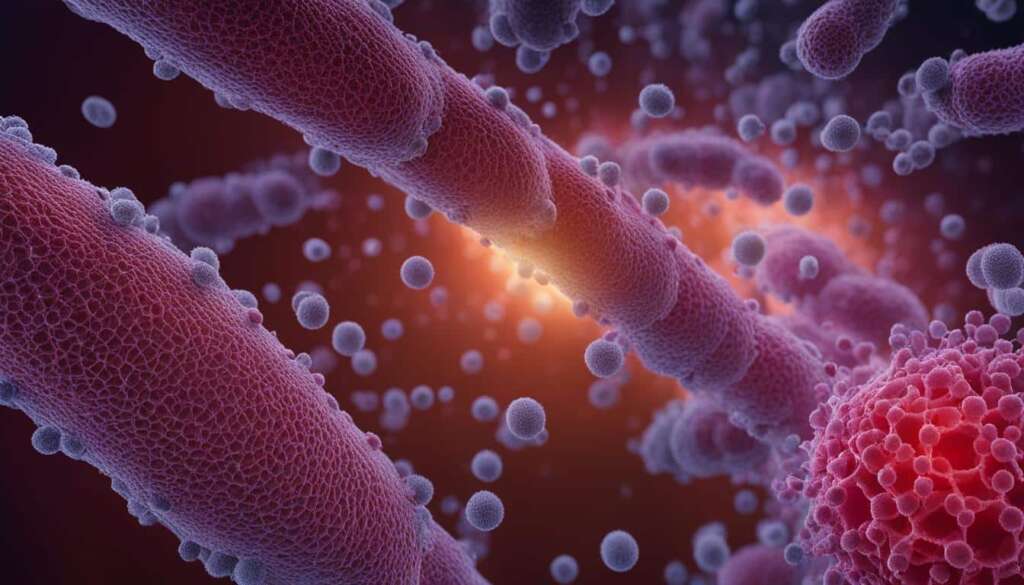Table of Contents
Nanotechnology, with its life-changing potential, is shaping the future of various industries and scientific advancements. By understanding and controlling matter at the nanoscale, nanotechnology enables innovative applications and unlocks novel properties.
With the ability to manipulate materials at the atomic level, nanotechnology has the potential to revolutionize fields such as materials science, nanomedicine, and device engineering. By harnessing the unique properties of nanomaterials, we can develop stronger and more durable materials, create advanced medical treatments, and improve electronic devices.
Key Takeaways:
- Nanotechnology has immense potential to transform various industries and scientific fields.
- Understanding and controlling matter at the nanoscale unlocks unique properties and applications.
- Nanomedicine, materials science, and device engineering are just a few areas where nanotechnology is making a significant impact.
- By harnessing nanomaterials, we can develop stronger materials, advanced medical treatments, and improved electronic devices.
- The future of nanotechnology holds incredible promise and will continue to shape our lives in the years to come.
What is Nanotechnology?
Nanotechnology refers to the manipulation and control of matter at the nanoscale, which is between approximately 1 and 100 nanometers. At this scale, materials exhibit unique physical, chemical, and biological properties that differ from their bulk counterparts. Nanotechnology enables us to create materials with enhanced strength, conductivity, and reactivity. It has applications in various fields, including materials science, nanomedicine, and device engineering.
Applications of Nanoparticles
Nanoparticles play a crucial role in the field of nanotechnology, serving as the fundamental building blocks with diverse applications across various industries. By harnessing nanotechnology-based principles, these tiny particles offer the potential to enhance materials and revolutionize a wide range of sectors.
Materials Science
In the field of materials science, nanoparticles have opened up new possibilities. By incorporating nanoparticles into materials, their properties can be significantly improved. For example, nanoparticles can make materials stronger, lighter, more durable, and better electrical conductors. These advancements enable the development of innovative and high-performance materials for various industries such as construction, automotive, and aerospace.
Nanomedicine
Nanoparticles have also revolutionized the field of nanomedicine, where they are used for applications ranging from drug delivery systems to gene sequencing technologies. The small size and unique properties of nanoparticles allow for precise targeting of specific cells or tissues in the body, increasing the effectiveness of drug therapies and reducing potential side effects. Nanoparticles are being explored for their potential in developing artificial organs and improving diagnostics, opening up new frontiers in healthcare.
Device Engineering
The field of device engineering has also been transformed by nanoparticles and nanotechnology-based principles. Nanoparticles enable the production of smaller, more efficient, and more reliable electronic devices. By incorporating nanoparticles into electronic components, such as transistors and sensors, devices can have increased processing power, improved energy efficiency, and enhanced sensitivity. This has paved the way for advancements in areas such as wearable technology, flexible electronics, and high-performance computing.
“The incorporation of nanoparticles into materials, drug delivery systems, and electronic devices has revolutionized industries and opened up new possibilities for innovation.”
In addition to these specific applications, nanoparticles have found use in various other industries. Some notable examples include:
- 3D Printing: Nanoparticles are used as ink materials in 3D printers to create intricate and precise structures.
- Environmental Remediation: Nanoparticles are employed to remove pollutants and contaminants from air, water, and soil.
- Cosmetics: Nanoparticles are used in beauty and skincare products to improve product performance and enhance the delivery of active ingredients.
- Energy Storage: Nanoparticles help improve the efficiency and capacity of batteries and supercapacitors for energy storage systems.
To visualize the widespread applications of nanoparticles, take a look at the table below, which highlights key industries and their specific uses of nanoparticles:
| Industry | Applications |
|---|---|
| Materials Science | Construction materials with enhanced strength and durability |
| Nanomedicine | Targeted drug delivery systems for improved medical treatments |
| Device Engineering | Nanoscale electronic components for smaller and more efficient devices |
| 3D Printing | Precise and intricate structures created using nanoparticle inks |
| Environmental Remediation | Nanoparticles for removing pollutants from air, water, and soil |
| Cosmetics | Nanoparticles improving product performance and ingredient delivery |
| Energy Storage | Increase battery and supercapacitor efficiency and capacity |
As illustrated, nanoparticles have a significant impact on numerous industries, driving innovation and improving various aspects of our everyday lives.
Materials Science
In the field of materials science, nanotechnology offers immense potential, leveraging the principles of nanoscale engineering, self-healing materials, and 3D printing. By manipulating matter at the atomic level, scientists and engineers can design materials with adaptive properties, resulting in stronger, more durable structures.
Nanoscale engineering allows for precise control over material composition and structure, resulting in enhanced performance characteristics. Materials engineered at the nanoscale exhibit unique properties, such as increased strength, improved conductivity, and enhanced reactivity. These properties make nanomaterials invaluable in various industries, including aerospace, electronics, and healthcare.
One exciting application of nanotechnology in materials science is self-healing materials. By incorporating nanoparticles into the material matrix, it becomes possible for these materials to repair themselves when damaged. Nanoparticles can migrate and fill in cracks or defects, preserving the structural integrity and prolonging the lifespan of the material.
“Nanotechnology allows us to create materials that can heal themselves, leading to more resilient and long-lasting structures.” – Dr. Rachel Johnson, Materials Scientist
Another area where nanotechnology has made significant contributions is 3D printing. This innovative technology enables the creation of complex three-dimensional objects, layer by layer, with exceptional precision. In materials science, 3D printing has been utilized to develop prosthetics, wearable sensors, and even components for high-performance jet engines.
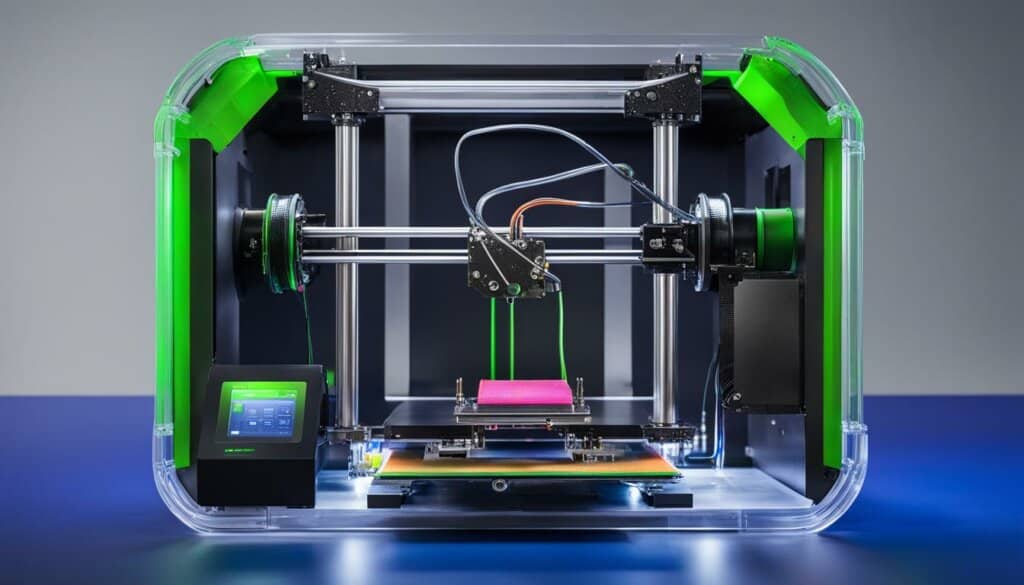
The ability to design and produce intricate structures with tailored properties using nanotechnology and 3D printing opens up endless possibilities in materials science. Scientists continue to explore new nanomaterial compositions and printing techniques to further enhance the properties and performance of engineered materials.
Nanomedicine
Nanomedicine offers promising solutions for healthcare. By utilizing nanotechnology, researchers are developing advanced drug delivery systems, imaging tools, and tissue engineering techniques. Nanoparticles can be targeted to specific locations in the body, making drug delivery more effective and reducing potential side effects.
Nanomedicine has a wide range of medical applications, including:
- Treatment of cancer: Nanoparticles can be designed to selectively kill cancer cells while leaving healthy cells unharmed, improving patient outcomes and reducing side effects.
- Drug delivery: Nanotechnology enables the efficient delivery of therapeutic compounds, such as drugs or genetic material, to targeted sites within the body. This targeted approach enhances drug efficacy and reduces systemic toxicity.
- Imaging: Nanoparticles can be used as contrast agents in medical imaging techniques, such as MRI and CT scans, allowing for enhanced visualization of tissues and organs. This improves diagnostic accuracy and enables early disease detection.
- Tissue engineering: Nanotechnology plays a crucial role in tissue engineering, where nanoscale scaffolds are used to support the growth and regeneration of damaged tissues. This technology has the potential to revolutionize organ transplantation and regenerative medicine.
Furthermore, nanotechnology is being applied in gene sequencing, the development of bionic organs, and 3D bioprinting, opening up new possibilities for personalized medicine and improving patient care.
“Nanomedicine holds great potential for revolutionizing medical treatments and enhancing patient care.” – Dr. Sarah Thompson, Nanomedicine Researcher
| Medical Application | Description |
|---|---|
| Cancer Treatment | Nanoparticles can deliver targeted therapy to cancer cells, reducing side effects and improving efficacy. |
| Drug Delivery | Nanotechnology enables precise drug delivery to specific sites within the body, enhancing treatment outcomes. |
| Imaging | Nanoparticles serve as contrast agents in medical imaging, improving visualization and diagnostic accuracy. |
| Tissue Engineering | Nanoscale scaffolds facilitate the growth and regeneration of damaged tissues, advancing organ transplantation and regenerative medicine. |
In conclusion, nanomedicine has the potential to revolutionize medical treatments through advanced drug delivery systems, imaging tools, and tissue engineering techniques. By harnessing the unique properties of nanoparticles, researchers are paving the way for improved patient care and personalized medicine.
Sensors and Self-healing Structures
Nanotechnology plays a crucial role in the development of sensors with enhanced capabilities. By utilizing nanomaterials and advanced manufacturing techniques, we can create sensors that are smaller, more complex, and more energy-efficient. This opens up opportunities for various applications, such as monitoring critical infrastructure like bridges and aircraft.
One exciting aspect of nanotechnology is the development of self-healing materials. These materials have the ability to repair themselves when damaged, extending their lifespan and reducing the need for costly repairs. By incorporating nanoparticles into the structure of a material, cracks and damages can be detected and repaired before they propagate further.
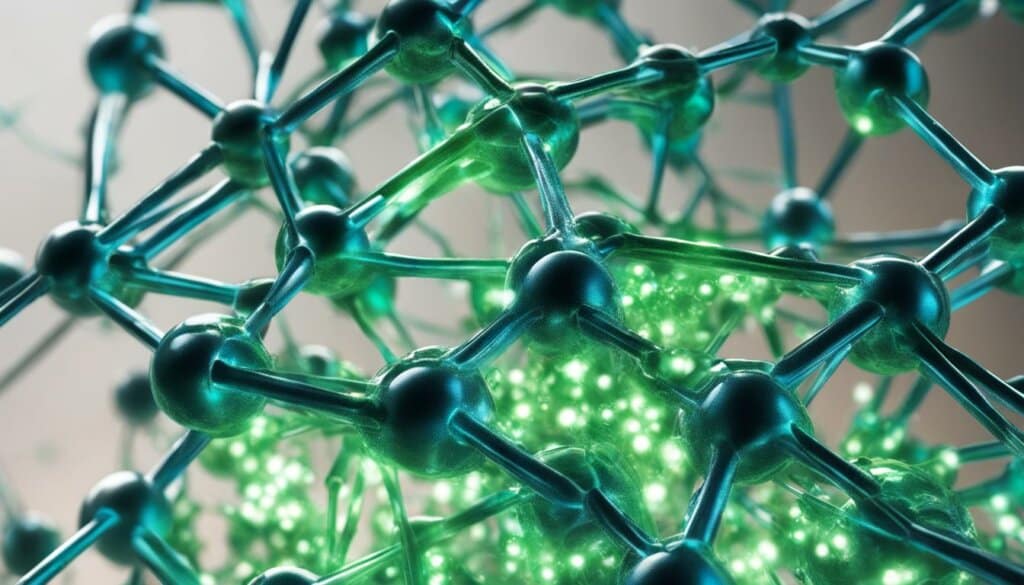
The self-healing process involves the nanoparticles migrating and filling in the cracks, restoring the material’s integrity. This technology has the potential to revolutionize industries like aerospace and microelectronics, where structural integrity is of utmost importance.
Big Data Processing and Energy Solutions
With the increasing prevalence of sensors, the amount of data generated has grown exponentially. In order to effectively manage and process this vast amount of information, big data processing is essential. Nanotechnology plays a crucial role in this field by enabling the development of ultra-dense memory that can store and process massive datasets.
Nanotechnology has revolutionized memory solutions, providing the means for high-capacity storage and efficient data processing. By manipulating materials at the nanoscale, scientists have been able to create memory devices with smaller footprints and greater storage capacity. This advancement allows for faster and more efficient data processing, facilitating advancements in various industries.
Nanotechnology has transformed the way we process big data. The ability to store and analyze large datasets is critical for making informed decisions and driving innovation.”
Nanotechnology Memory Advancements
Nanotechnology enables the development of memory solutions with enhanced performance and efficiency. Through the use of nanoscale structures and materials, memory devices can store more data in less space, resulting in higher storage capacities. This breakthrough is vital for industries that rely on big data processing, such as telecommunications, finance, and healthcare.
Additionally, nanotechnology memory solutions offer faster data access and transfer speeds, enabling real-time analysis and efficient data processing. This technology is invaluable for applications where quick decision-making and responsiveness are essential.
Energy Generation and Nanotexturing
Besides its impact on big data processing, nanotechnology also plays a crucial role in energy generation and storage. Nanotexturing, a technique that alters the surface properties of materials at the nanoscale, enhances energy storage and generation capabilities.
Nanotexturing increases the surface area of energy devices, allowing for more efficient energy transfer and storage. This advancement has significant applications in the development of electric cars, solar panels, and other renewable energy solutions. By incorporating nanotechnology, these devices can generate more energy from available resources, contributing to a greener and more sustainable future.
Applications of Nanotechnology in Energy Solutions
| Nanotechnology Applications | Energy Solution |
|---|---|
| Nanomaterials and nanotexturing | Improved solar panel efficiency and energy harvesting |
| Nanostructured batteries | Enhanced energy storage capacity and longer battery life |
| Energy harvesting devices | Generation of electricity from ambient sources |
| Nanomaterials for catalysis | Efficient conversion of energy into usable forms |
In summary, nanotechnology plays a vital role in big data processing and energy solutions. It enables the development of ultra-dense memory for managing and processing large datasets effectively. Additionally, nanotechnology contributes to advancements in energy generation and storage through techniques like nanotexturing. As research and innovation in nanotechnology continue, we can expect further breakthroughs that will have a transformative impact on data processing and energy solutions.
Nanotechnology and Climate Change
Nanotechnology plays a pivotal role in addressing the urgent challenge of climate change. By leveraging nanomaterials and innovative techniques, breakthroughs in renewable energy, energy efficiency, and climate change mitigation can be realized. These advancements have the potential to reduce greenhouse gas emissions and promote sustainable solutions for a greener future.
Enhancing Renewable Energy
Renewable energy sources, such as solar power, are vital for transitioning to a low-carbon economy. Nanotechnology has significantly contributed to improving the efficiency and affordability of solar panels, making them a more viable option. By incorporating nanomaterials, solar panels can capture and convert sunlight with greater efficiency, boosting energy production and reducing reliance on fossil fuels. This technology is paving the way for widespread adoption of renewable energy systems.
Revolutionizing Energy Storage
Effective energy storage is crucial for integrating renewable energy into the grid and ensuring a stable power supply. Nanotechnology offers innovative solutions for increasing the energy storage capacity and lifespan of batteries, particularly in electric cars. Through nanotexturing techniques, the surface area of battery electrodes can be enhanced, allowing for faster charging and discharging. This breakthrough improves the overall efficiency and range of electric vehicles, making them more practical and sustainable options for transportation.
Harvesting Energy from Multiple Sources
Nanotechnology also holds promise in harnessing energy from diverse sources. Researchers are exploring the potential of nanogenerators that harvest energy from mechanical movements, such as vibrations or wind. Additionally, temperature variations can be tapped using nanoscale thermoelectric materials, which can convert waste heat into usable electrical energy. These advancements in energy harvesting offer opportunities for powering small electronics and reducing the environmental impact of traditional energy generation methods.
“Nanotechnology allows us to unlock the full potential of renewable energy, paving the way for a sustainable and resilient future.” – Dr. Sarah Thompson, Director of Nanoscience Research Institute
| Nanotechnology Applications | Impact on Climate Change |
|---|---|
| Enhanced solar panels | Increased renewable energy generation |
| Nanostructured batteries | Improved energy storage efficiency |
| Nanogenerators | Energy harvesting from mechanical movements |
| Thermoelectric materials | Conversion of waste heat into electricity |
The table above summarizes some key nanotechnology applications and their positive impact on climate change mitigation. Through continuous research and innovation, nanotechnology will continue to drive advancements in renewable energy, energy efficiency, and sustainable practices, paving the way for a cleaner and greener planet.

Conclusion
The future of nanotechnology holds tremendous promise and potential. Ongoing research and development in this field will continue to revolutionize various industries and significantly improve our daily lives. From advancements in healthcare to materials science, sensors, and energy solutions, nanotechnology is set to drive transformative changes and shape the future.
By exploring and harnessing the power of the nanoscale, scientists and engineers can unlock further breakthroughs and push the boundaries of what is possible. Nanotechnology has already shown remarkable capabilities in creating stronger materials, enhancing drug delivery systems, developing self-healing structures, and enabling energy-efficient solutions.
As we delve deeper into the realm of nanotechnology, we can expect to witness even more astonishing advancements that will have a profound impact on society. The transformative potential of nanotechnology is immense, and its continued progress will pave the way for a future where technological innovation knows no bounds.
FAQ
What is nanotechnology?
Nanotechnology refers to the manipulation and control of matter at the nanoscale, which is between approximately 1 and 100 nanometers. At this scale, materials exhibit unique physical, chemical, and biological properties that differ from their bulk counterparts. Nanotechnology enables us to create materials with enhanced strength, conductivity, and reactivity. It has applications in various fields, including materials science, nanomedicine, and device engineering.
What are nanoparticles and their applications?
Nanoparticles are the building blocks of nanotechnology and have diverse applications across various industries. By utilizing nanotechnology-based principles, materials can be made stronger, lighter, more durable, and better electrical conductors. Some key applications of nanoparticles include materials science (construction), nanomedicine (healthcare), and device engineering (electronics and wearables). Nanoparticles are already being used in 3D printing, drug delivery systems, gene sequencing technologies, and the development of artificial organs.
How does nanotechnology impact materials science?
In the field of materials science, nanotechnology has significant potential. Nanoscale engineering allows the creation of stronger, more durable, and self-healing materials. By manipulating materials at the atomic level, it is possible to design structures with adaptive properties. Nanotechnology also plays a crucial role in 3D printing, which enables the creation of complex objects layer by layer. This technology has already been used to develop prosthetics, wearable sensors, and parts for jet engines.
What are the applications of nanotechnology in healthcare?
Nanomedicine offers promising solutions for healthcare. By utilizing nanotechnology, researchers are developing advanced drug delivery systems, imaging tools, and tissue engineering techniques. Nanoparticles can be targeted to specific locations in the body, making drug delivery more effective and reducing potential side effects. Nanotechnology is also being used for gene sequencing, the development of bionic organs, and 3D bioprinting. These advancements hold the potential to revolutionize medical treatments and enhance patient care.
How does nanotechnology contribute to sensors and self-healing structures?
Nanotechnology plays a crucial role in the development of sensors with enhanced capabilities. By utilizing nanomaterials and advanced manufacturing techniques, sensors can be made smaller, more complex, and more energy-efficient. This opens up opportunities for various applications, such as monitoring critical infrastructure like bridges and aircraft. Additionally, nanotechnology enables the development of self-healing materials, where nanoparticles can migrate and fill in cracks to prevent further damage. This technology has the potential to revolutionize industries like aerospace and microelectronics.
What is the role of nanotechnology in big data processing and energy solutions?
As sensors become more prevalent, the amount of data generated increases exponentially. Nanotechnology is crucial for the development of ultra-dense memory, enabling the storage and processing of big data. Furthermore, nanotechnology plays a role in energy generation and storage. Nanotexturing and nanomaterials increase the surface area of devices, leading to more efficient energy storage and generation. This technology has applications in electric cars, solar panels, and the potential for harvesting energy from the environment.
How does nanotechnology contribute to tackling climate change?
Nanotechnology has already contributed to tackling climate change by enabling advancements in renewable energy. By utilizing nanomaterials, solar panels can convert more sunlight into electricity, while nanotexturing increases the energy storage capacity of batteries for electric cars. Nanotechnology also holds potential for energy harvesting from movement, temperature variations, and other sources. These advancements have the potential to reduce greenhouse gas emissions and promote sustainable energy solutions in the fight against climate change.
What does the future hold for nanotechnology?
The future of nanotechnology holds tremendous promise and potential. With ongoing research and development, nanotechnology will continue to revolutionize various industries and improve our daily lives. From healthcare to materials science, sensors, and energy solutions, nanotechnology is driving advancements that will shape the future. As we continue to explore and harness the power of the nanoscale, we can expect further breakthroughs that will have a transformative impact on society.

